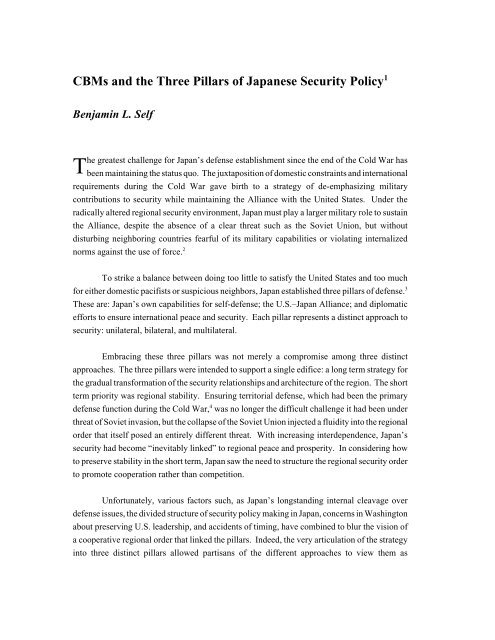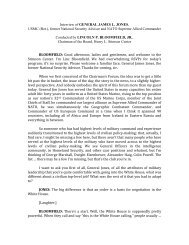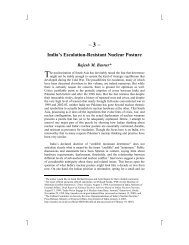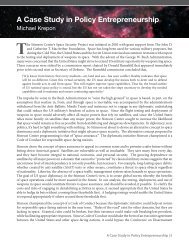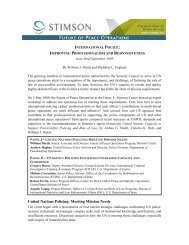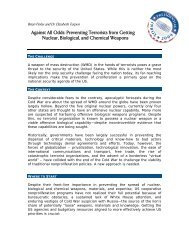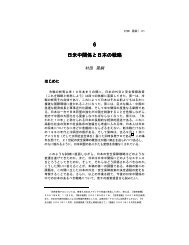CBMs and the Three Pillars of Japanese Security Policy, by ...
CBMs and the Three Pillars of Japanese Security Policy, by ...
CBMs and the Three Pillars of Japanese Security Policy, by ...
Create successful ePaper yourself
Turn your PDF publications into a flip-book with our unique Google optimized e-Paper software.
<strong>CBMs</strong> <strong>and</strong> <strong>the</strong> <strong>Three</strong> <strong>Pillars</strong> <strong>of</strong> <strong>Japanese</strong> <strong>Security</strong> <strong>Policy</strong> 1<br />
Benjamin L. Self<br />
The greatest challenge for Japan’s defense establishment since <strong>the</strong> end <strong>of</strong> <strong>the</strong> Cold War has<br />
been maintaining <strong>the</strong> status quo. The juxtaposition <strong>of</strong> domestic constraints <strong>and</strong> international<br />
requirements during <strong>the</strong> Cold War gave birth to a strategy <strong>of</strong> de-emphasizing military<br />
contributions to security while maintaining <strong>the</strong> Alliance with <strong>the</strong> United States. Under <strong>the</strong><br />
radically altered regional security environment, Japan must play a larger military role to sustain<br />
<strong>the</strong> Alliance, despite <strong>the</strong> absence <strong>of</strong> a clear threat such as <strong>the</strong> Soviet Union, but without<br />
disturbing neighboring countries fearful <strong>of</strong> its military capabilities or violating internalized<br />
norms against <strong>the</strong> use <strong>of</strong> force. 2<br />
To strike a balance between doing too little to satisfy <strong>the</strong> United States <strong>and</strong> too much<br />
for ei<strong>the</strong>r domestic pacifists or suspicious neighbors, Japan established three pillars <strong>of</strong> defense. 3<br />
These are: Japan’s own capabilities for self-defense; <strong>the</strong> U.S.–Japan Alliance; <strong>and</strong> diplomatic<br />
efforts to ensure international peace <strong>and</strong> security. Each pillar represents a distinct approach to<br />
security: unilateral, bilateral, <strong>and</strong> multilateral.<br />
Embracing <strong>the</strong>se three pillars was not merely a compromise among three distinct<br />
approaches. The three pillars were intended to support a single edifice: a long term strategy for<br />
<strong>the</strong> gradual transformation <strong>of</strong> <strong>the</strong> security relationships <strong>and</strong> architecture <strong>of</strong> <strong>the</strong> region. The short<br />
term priority was regional stability. Ensuring territorial defense, which had been <strong>the</strong> primary<br />
defense function during <strong>the</strong> Cold War, 4 was no longer <strong>the</strong> difficult challenge it had been under<br />
threat <strong>of</strong> Soviet invasion, but <strong>the</strong> collapse <strong>of</strong> <strong>the</strong> Soviet Union injected a fluidity into <strong>the</strong> regional<br />
order that itself posed an entirely different threat. With increasing interdependence, Japan’s<br />
security had become “inevitably linked” to regional peace <strong>and</strong> prosperity. In considering how<br />
to preserve stability in <strong>the</strong> short term, Japan saw <strong>the</strong> need to structure <strong>the</strong> regional security order<br />
to promote cooperation ra<strong>the</strong>r than competition.<br />
Unfortunately, various factors such, as Japan’s longst<strong>and</strong>ing internal cleavage over<br />
defense issues, <strong>the</strong> divided structure <strong>of</strong> security policy making in Japan, concerns in Washington<br />
about preserving U.S. leadership, <strong>and</strong> accidents <strong>of</strong> timing, have combined to blur <strong>the</strong> vision <strong>of</strong><br />
a cooperative regional order that linked <strong>the</strong> pillars. Indeed, <strong>the</strong> very articulation <strong>of</strong> <strong>the</strong> strategy<br />
into three distinct pillars allowed partisans <strong>of</strong> <strong>the</strong> different approaches to view <strong>the</strong>m as
94<br />
CBMS <strong>and</strong> <strong>Three</strong> <strong>Security</strong> <strong>Pillars</strong> <strong>of</strong> <strong>Japanese</strong> <strong>Security</strong> <strong>Policy</strong><br />
alternatives ra<strong>the</strong>r than components. Instead <strong>of</strong> working in harmony, Japan’s efforts in <strong>the</strong><br />
unilateral, bilateral, <strong>and</strong> multilateral arenas are increasingly falling into competition with each<br />
o<strong>the</strong>r. Ra<strong>the</strong>r than a single strategy, Tokyo appears to be pursuing policies along various lines,<br />
where streng<strong>the</strong>ning one <strong>of</strong> <strong>the</strong> pillars saps <strong>the</strong> o<strong>the</strong>rs.<br />
To remedy this problem, Japan must develop ways for its policies to work toge<strong>the</strong>r at<br />
every level, not merely at <strong>the</strong> very broadest. This essay cannot provide all <strong>the</strong> answers, but<br />
begins <strong>the</strong> process <strong>of</strong> searching for <strong>the</strong>m. One avenue to achieve this is more creative <strong>and</strong><br />
effective use <strong>of</strong> confidence-building measures (CBMS) for regional security. CBMS can help<br />
both to streng<strong>the</strong>n <strong>the</strong> Alliance <strong>and</strong> make it less threatening to Japan’s neighbors. Working<br />
toward a cooperative regional security order through various channels is still a reasonable<br />
approach, but if <strong>the</strong> separate efforts are not integrated, <strong>the</strong>n short term friction will impede<br />
progress toward <strong>the</strong> long term goal.<br />
ESTABLISHING THE THREE PILLARS<br />
Political volatility <strong>and</strong> <strong>the</strong> lack <strong>of</strong> expertise on security issues within <strong>the</strong> <strong>Japanese</strong> elite<br />
hindered <strong>the</strong> adaptation to new circumstances after <strong>the</strong> Cold War ended. But it was not simply<br />
a matter <strong>of</strong> <strong>the</strong> people in charge; <strong>the</strong> very structure <strong>of</strong> national security policy making in Japan<br />
had been designed to be inefficient, to prevent sudden shifts in military posture or doctrine.<br />
Fur<strong>the</strong>rmore, <strong>the</strong> <strong>Japanese</strong> had become extremely comfortable with <strong>the</strong> existing security<br />
arrangements <strong>and</strong> few were eager to change. As a result <strong>of</strong> conflicting pressures <strong>and</strong> reluctance<br />
to take any drastic actions, Japan’s defense policy responded very slowly to <strong>the</strong> changed<br />
environment.<br />
The <strong>Japanese</strong> government’s approach to security had previously involved all <strong>the</strong><br />
elements <strong>of</strong> <strong>the</strong> three pillar strategy, but <strong>the</strong>y had not been explicitly identified as such. The<br />
1957 Basic <strong>Policy</strong> for National Defense cites <strong>the</strong> need to “support <strong>the</strong> activities <strong>of</strong> <strong>the</strong> United<br />
Nations <strong>and</strong> promote international cooperation,” along with developing <strong>the</strong> capabilities for selfdefense<br />
<strong>and</strong> maintaining <strong>the</strong> U.S.–Japan Alliance. 5 However, <strong>the</strong> framework for security policy<br />
has clearly been substantially altered under <strong>the</strong> 1995 revision <strong>of</strong> <strong>the</strong> National Defense Program<br />
Outline (NDPO). Each <strong>of</strong> <strong>the</strong> three pillars has been subsequently streng<strong>the</strong>ned.
Japan’s self-defense capabilities<br />
Benjamin L. Self 95<br />
The Japan Defense Agency (JDA) maintains that <strong>the</strong> Self-Defense Forces (SDF)<br />
constitute <strong>the</strong> defense capability necessary <strong>and</strong> sufficient for deterring or repelling an attack<br />
against <strong>Japanese</strong> territory. The Maritime SDF is widely considered <strong>the</strong> most powerful naval<br />
force in Asia, aside from <strong>the</strong> U.S. Seventh Fleet, possessing advanced equipment such as Aegis<br />
cruisers <strong>and</strong> <strong>the</strong> world’s largest Anti-Submarine Warfare (ASW) fleet. The Air SDF is likewise<br />
equipped with state-<strong>of</strong>-<strong>the</strong>-art aircraft, including AWACS planes <strong>and</strong> <strong>the</strong> advanced, codeveloped<br />
F-2. Finally, <strong>the</strong> Ground SDF, although small among Asian armies with a troop<br />
strength <strong>of</strong> 145,000 active-duty personnel <strong>and</strong> 15,000 reserves, is highly trained <strong>and</strong> maintains<br />
advanced capabilities for ground-based air-defense <strong>and</strong> sea-defense. It also has <strong>the</strong> armor,<br />
artillery, <strong>and</strong> infantry to withst<strong>and</strong> a limited invasion, should any enemies manage to reach l<strong>and</strong>.<br />
The original 1976 NDPO defined <strong>the</strong> SDF’s role as defense against a limited attack on<br />
Japan until such time as <strong>the</strong> United States could come to Japan’s aid. This narrow scope drew<br />
from a recognition that a defense build-up designed to allow Japan counter <strong>the</strong> Soviet Union in<br />
<strong>the</strong> Pacific would overburden <strong>the</strong> <strong>Japanese</strong> economy <strong>and</strong> undermine <strong>the</strong> conservative<br />
government. After <strong>the</strong> collapse <strong>of</strong> <strong>the</strong> Soviet Union, <strong>the</strong> regional environment was expected to<br />
be much more benign, opening <strong>the</strong> possibility <strong>of</strong> a reduction <strong>of</strong> SDF capabilities to an even<br />
lower level. The various branches <strong>of</strong> <strong>the</strong> SDF also have supplemental roles, such as disaster<br />
relief, but <strong>the</strong>ir main mission is to provide unilateral military capability for <strong>the</strong> defense <strong>of</strong> Japan.<br />
Under <strong>the</strong> 1995 NDPO, self-defense has emerged from <strong>the</strong> shadow <strong>of</strong> <strong>the</strong> Alliance to become<br />
a major pillar <strong>of</strong> Japan’s overall defense strategy.<br />
The Alliance<br />
The second pillar <strong>of</strong> Japan’s defense is <strong>the</strong> U.S.–Japan Alliance. The Alliance has, since<br />
its revision in 1960, committed <strong>the</strong> United States to <strong>the</strong> defense <strong>of</strong> Japan. The treaty is mutual<br />
but not reciprocal; Japan obtained a security guarantee in exchange for providing facilities for<br />
U.S. forward-deployed forces. At present <strong>the</strong>se consist <strong>of</strong> over 60,000 American personnel,<br />
including <strong>the</strong> Third Marine Expeditionary Force <strong>and</strong> <strong>the</strong> Seventh Fleet. While <strong>the</strong> provision <strong>of</strong><br />
bases was sufficient to win U.S. defense guarantees in <strong>the</strong> early Cold War years, Japan gradually<br />
faced <strong>the</strong> need to <strong>of</strong>fer additional support to <strong>the</strong> Alliance to placate U.S. dem<strong>and</strong>s for “burden<br />
sharing” from <strong>the</strong> Nixon Doctrine onward. This has led Japan to provide Host Nation Support<br />
(HNS) to <strong>the</strong> United States, covering salaries <strong>of</strong> local hires, construction <strong>and</strong> maintenance on<br />
bases, fuel, <strong>and</strong> so on. Increasing financial contributions have been <strong>the</strong> main avenue for
96<br />
CBMS <strong>and</strong> <strong>Three</strong> <strong>Security</strong> <strong>Pillars</strong> <strong>of</strong> <strong>Japanese</strong> <strong>Security</strong> <strong>Policy</strong><br />
redressing <strong>the</strong> fundamental asymmetry <strong>of</strong> <strong>the</strong> Alliance relationship since HNS was introduced<br />
in 1976.<br />
Since <strong>the</strong> Soviet threat was <strong>the</strong> Alliance’s main rationale, doubts emerged about its<br />
sustainability in <strong>the</strong> post-Cold War era. Given <strong>the</strong> long-st<strong>and</strong>ing opposition to <strong>the</strong> Alliance<br />
among large segments <strong>of</strong> <strong>the</strong> <strong>Japanese</strong> public, <strong>and</strong> high levels <strong>of</strong> hostility in <strong>the</strong> U.S. Congress<br />
towards Japan’s “free riding” traditional role, smooth continuation <strong>of</strong> <strong>the</strong> Alliance relationship<br />
was far from assured. Dedicated public servants on both sides, <strong>and</strong> a bit <strong>of</strong> luck, made its<br />
survival possible. 6 Japan has maintained <strong>the</strong> Alliance as a core element <strong>of</strong> its national security<br />
strategy, arguing that <strong>the</strong> engagement <strong>of</strong> <strong>the</strong> United States <strong>and</strong> U.S. military presence are vital<br />
for peace <strong>and</strong> stability in <strong>the</strong> region. 7 The 1995 NDPO cited <strong>the</strong> need to pay “due attention to<br />
enhancing <strong>the</strong> credibility <strong>of</strong> <strong>the</strong> Japan-U.S. <strong>Security</strong> Arrangements,” revealing Tokyo’s position<br />
<strong>of</strong> preparing to make it more clear that support for <strong>the</strong> Alliance is a function <strong>of</strong> <strong>the</strong> SDF.<br />
Although <strong>the</strong> 1995 NDPO itself defines those functions as national defense, disaster relief, <strong>and</strong><br />
support for multilateralism, <strong>the</strong> subsequent 1997 review <strong>of</strong> <strong>the</strong> Guidelines for U.S.–Japan<br />
Defense Cooperation resulted in a well-delineated set <strong>of</strong> tasks which <strong>the</strong> <strong>Japanese</strong> would<br />
perform in support <strong>of</strong> U.S. forces in <strong>the</strong> region. In this sense <strong>the</strong> SDF can contribute to <strong>the</strong><br />
Alliance in <strong>the</strong> Far East, beyond <strong>the</strong> defense <strong>of</strong> Japan proper, as articulated in Article VI <strong>of</strong> <strong>the</strong><br />
Mutual <strong>Security</strong> Treaty.<br />
Multilateral cooperation<br />
The third pillar is less familiar <strong>and</strong> less tangible, but perhaps best represents <strong>the</strong><br />
direction <strong>of</strong> <strong>Japanese</strong> defense thinking after <strong>the</strong> Cold War. It draws on <strong>the</strong> tradition <strong>of</strong> nonmilitary<br />
efforts to achieve security, embodied in <strong>the</strong> doctrine <strong>of</strong> Comprehensive <strong>Security</strong><br />
formulated under Prime Minister Ohira Masayoshi. It also adopts many <strong>of</strong> <strong>the</strong> precepts <strong>of</strong><br />
security cooperation as formulated <strong>and</strong> practiced in Europe, with its strong focus on<br />
multilateralism. In this sense <strong>the</strong> third pillar embodies a liberal view <strong>of</strong> security, in which a<br />
community <strong>of</strong> nations can transcend a balance <strong>of</strong> power paradigm to achieve cooperative<br />
security. The key elements <strong>of</strong> this third pillar are economic cooperation, security dialogues, <strong>and</strong><br />
support for multilateral organizations.<br />
The most prominent among <strong>the</strong>se elements are Japan’s economic cooperation <strong>and</strong> aid.<br />
Tokyo’s Official Development Assistance (ODA) strategy has been well investigated 8 from <strong>the</strong><br />
economic <strong>and</strong> diplomatic perspective, if not as a part <strong>of</strong> national security strategy. ODA<br />
emerged out <strong>of</strong> war reparations to Sou<strong>the</strong>ast Asia, <strong>and</strong> was initially aimed primarily at exp<strong>and</strong>ing
Benjamin L. Self 97<br />
export markets. Under <strong>the</strong> Ohira cabinet, development assistance <strong>and</strong> economic cooperation<br />
became more <strong>of</strong> a national security policy tool, serving both to improve Japan’s ties with its<br />
neighbors <strong>and</strong> to assuage American dem<strong>and</strong>s for burden sharing through “strategic aid” to U.S.<br />
client states. Since <strong>the</strong> end <strong>of</strong> <strong>the</strong> Cold War, aid has been a major means <strong>by</strong> which Tokyo helps<br />
develop a structure <strong>of</strong> economic interdependence in <strong>the</strong> Asia-Pacific region. Recently, however,<br />
two factors have begun to weaken slightly Japan’s willingness to rely on this approach alone.<br />
First is <strong>the</strong> relative decline <strong>of</strong> <strong>Japanese</strong> economic power <strong>and</strong> <strong>the</strong> increasingly precarious<br />
financial position <strong>of</strong> <strong>the</strong> central government. With deficits running as high as 13 percent <strong>of</strong><br />
Gross Domestic Produce (GDP) <strong>and</strong> a national debt that exceeds 100 percent <strong>of</strong> GDP, Tokyo<br />
no longer has <strong>the</strong> wherewithal to continue exp<strong>and</strong>ing its aid budget. Secondly, <strong>Japanese</strong> are<br />
doubting <strong>the</strong> effectiveness <strong>of</strong> aid as a political tool, given evidence such as China’s belligerence<br />
over nuclear testing in 1995 9 <strong>and</strong> India’s <strong>and</strong> Pakistan’s testing <strong>of</strong> nuclear weapons in 1998.<br />
Support for multilateral organizations has deep roots in Japan, where <strong>the</strong> United Nations<br />
embodies <strong>the</strong> legitimacy <strong>of</strong> <strong>the</strong> state system <strong>and</strong> <strong>of</strong>fers <strong>the</strong> sole sanction for <strong>the</strong> use <strong>of</strong> force in<br />
international politics. The strength <strong>of</strong> <strong>Japanese</strong> affection for <strong>the</strong> United Nations (UN) system<br />
is evident in <strong>the</strong> public approval <strong>of</strong> SDF participation in UN Peacekeeping Operations (PKO),<br />
despite strong initial reluctance to allow <strong>the</strong> overseas dispatch <strong>of</strong> <strong>Japanese</strong> troops. 10 This<br />
category <strong>of</strong> “international contribution” is so popular that it has assumed a prominent <strong>of</strong>ficial<br />
place in <strong>the</strong> SDF’s roles <strong>and</strong> missions. The 1995 NDPO defines three major roles for <strong>the</strong> SDF,<br />
including <strong>the</strong> defense <strong>of</strong> Japan (as discussed above), response to disasters <strong>and</strong> humanitarian<br />
emergencies, 11 <strong>and</strong> “contribution to <strong>the</strong> creation <strong>of</strong> a more stable security environment.” This<br />
contribution can take <strong>the</strong> form <strong>of</strong> direct participation in UN PKO, as well as cooperation with<br />
UN <strong>and</strong> o<strong>the</strong>r efforts for arms control, disarmament, <strong>and</strong> non-proliferation.<br />
The newest aspect <strong>of</strong> Japan’s strategy to streng<strong>the</strong>n <strong>the</strong> third pillar is support for security<br />
dialogues, defense exchanges, <strong>and</strong> o<strong>the</strong>r forms <strong>of</strong> CBMS. Official documents such as Defense<br />
<strong>of</strong> Japan white papers, diplomatic blue books, <strong>and</strong> <strong>the</strong> 1995 NDPO explicitly call for promotion<br />
<strong>of</strong> security dialogues <strong>and</strong> defense exchanges on a bilateral <strong>and</strong> multilateral basis. A web <strong>of</strong><br />
bilateral contacts with Russia, South Korea, <strong>and</strong> China has been in place since <strong>the</strong> mid 1990s,<br />
<strong>and</strong> a range <strong>of</strong> Track Two multilateral forums has been developed to discuss security issues. 12<br />
Fur<strong>the</strong>rmore, <strong>the</strong> creation <strong>of</strong> an <strong>of</strong>ficial security dialogue process for <strong>the</strong> entire Asia-Pacific<br />
region in <strong>the</strong> form <strong>of</strong> <strong>the</strong> ASEAN Regional Forum (ARF) has not only provided a venue for<br />
exchanging information <strong>and</strong> views, but has also provided <strong>the</strong> possible beginnings <strong>of</strong> a<br />
multilateral cooperative security structure. Japan participates avidly in <strong>the</strong>se bodies, <strong>and</strong> also<br />
hosts a welter <strong>of</strong> multilateral meetings through <strong>the</strong> Defense Agency, <strong>the</strong> National Institute for
98<br />
CBMS <strong>and</strong> <strong>Three</strong> <strong>Security</strong> <strong>Pillars</strong> <strong>of</strong> <strong>Japanese</strong> <strong>Security</strong> <strong>Policy</strong><br />
Defense Studies, <strong>and</strong> <strong>the</strong> Defense Academy, as well as <strong>the</strong> Foreign Ministry <strong>and</strong> its affiliated<br />
organizations. The stated purpose <strong>of</strong> all <strong>of</strong> <strong>the</strong>se activities is to “enhance mutual confidence.”<br />
CBMS have quickly earned a place as a core component <strong>of</strong> Japan’s overall national security<br />
strategy, <strong>and</strong> are to be integrated into a comprehensive approach to security in which <strong>the</strong> three<br />
pillars—self-defense, Alliance, <strong>and</strong> cooperation work—in harmony. Realization <strong>of</strong> this strategy<br />
will depend on well-planned implementation <strong>of</strong> CBMS, as part <strong>of</strong> a more coherent vision <strong>of</strong> a<br />
regional security structure buttressed <strong>by</strong> efforts at <strong>the</strong> unilateral, bilateral, <strong>and</strong> multilateral levels.<br />
THE IMPORTANCE OF EACH PILLAR<br />
There are excellent reasons for pursuing each <strong>of</strong> <strong>the</strong> three approaches, <strong>and</strong> each has<br />
partisan support. Unilateral efforts for self-defense are <strong>the</strong> norm across <strong>the</strong> international<br />
community, <strong>and</strong> in an environment characterized <strong>by</strong> most scholars <strong>of</strong> international relations as<br />
“anarchic” such efforts are indispensable. If a pure collective security structure were feasible,<br />
it would still require national capabilities to support its functioning. Such capabilities could be<br />
expected to gradually evolve from existing militaries. Even with every intention <strong>of</strong> cooperating<br />
with <strong>the</strong> international community in general <strong>and</strong> abiding <strong>by</strong> its constitutional provision to avoid<br />
<strong>the</strong> use or threat <strong>of</strong> force to resolve international disputes, Japan would need military<br />
capabilities. Moreover, Japan has articulated how enhancing its military capabilities on a<br />
unilateral basis is intended also to support <strong>the</strong> forward-deployed forces <strong>of</strong> <strong>the</strong> United States. The<br />
Acquisition <strong>and</strong> Cross-Servicing Agreement (ACSA), followed <strong>by</strong> <strong>the</strong> revised Guidelines <strong>of</strong><br />
1997, established <strong>the</strong> framework for such synergy. O<strong>the</strong>r aspects <strong>of</strong> SDF streng<strong>the</strong>ning are<br />
oriented toward multilateral cooperation, such as more long-range transport aircraft for<br />
deployment <strong>of</strong> peacekeepers or evacuation <strong>of</strong> non-combatants <strong>and</strong> refugees.<br />
The Alliance likewise has persuasive justifications. In its favor, advocates note <strong>the</strong> need<br />
to keep <strong>the</strong> United States engaged in <strong>the</strong> region in a time <strong>of</strong> strategic fluidity, especially since<br />
<strong>the</strong> U.S. military is almost universally accepted as a stabilizing presence. In regard to those who<br />
do not appreciate <strong>the</strong> American presence, North Korea for example, many <strong>Japanese</strong> feel <strong>the</strong><br />
Alliance is still important for its deterrent function. Ano<strong>the</strong>r argument is that if <strong>the</strong> Alliance<br />
were weakened or terminated, not only would <strong>the</strong> U.S. withdrawal leave a power vacuum, but<br />
also <strong>Japanese</strong> defense capability would most likely increase sharply, destabilizing relations with<br />
its neighbors. This line <strong>of</strong> reasoning is popular among past victims <strong>of</strong> <strong>Japanese</strong> aggression, <strong>and</strong>,
Benjamin L. Self 99<br />
ironically, is also prevalent among leftists in Japan who formerly opposed <strong>the</strong> Alliance for fear<br />
<strong>the</strong> United States would drag Japan into war. This “cap in <strong>the</strong> bottle” function <strong>of</strong> <strong>the</strong> Alliance<br />
is decidedly unpopular among mainstream <strong>Japanese</strong>, however.<br />
The third pillar represents <strong>the</strong> strong <strong>Japanese</strong> preference for a non-military approach<br />
to security. More precisely, <strong>by</strong> pursuing a liberal vision <strong>of</strong> cooperation in security affairs 13 , it<br />
allows Japan to avoid “power politics.” If <strong>the</strong> first two pillars constitute what is necessary for<br />
practical reasons, <strong>the</strong> third pillar is necessary in order for policy to reflect Japan’s aspirations.<br />
The cooperative approach also works to improve security relationships in <strong>the</strong> region might that<br />
are characterized <strong>by</strong> mutual suspicion. Left uncorrected, such an environment could degenerate<br />
into hostility <strong>and</strong> arms racing. 14 While some realists argue that <strong>the</strong> nature <strong>of</strong> international<br />
politics makes such suspicions entirely natural <strong>and</strong> appropriate, <strong>by</strong> working to defuse <strong>the</strong>m <strong>and</strong><br />
generate an atmosphere <strong>of</strong> trust, <strong>the</strong> third pillar can help achieve security at a lower cost <strong>and</strong><br />
lower chance <strong>of</strong> war than can deterrence alone.<br />
STRUCTURAL WEAKNESS IN EACH OF THE THREE PILLARS<br />
Although each <strong>of</strong> <strong>the</strong> pillars represents policy approaches that Japan clearly needs to<br />
pursue, each presents some problems on its own or in interactions with <strong>the</strong> o<strong>the</strong>rs. While in<br />
<strong>the</strong>ory <strong>the</strong> streng<strong>the</strong>ning <strong>of</strong> any single element should buttress Japan’s security as a while, in<br />
practice each small step taken without regard for its broader context can complicate <strong>and</strong> confuse<br />
Japan’s overall strategy.<br />
Self-Defense Efforts<br />
First, despite <strong>the</strong> nearly fifty year history <strong>of</strong> <strong>the</strong> SDF, <strong>the</strong>re are still concerns about<br />
Japan’s unilateral efforts to enhance its security. Such concerns are entirely natural in an<br />
anarchic environment, where states compete for survival, but in this case <strong>the</strong>y are <strong>of</strong> course<br />
based not only on <strong>the</strong> nature <strong>of</strong> international politics itself but on Japan’s unfortunate history <strong>of</strong><br />
aggression. Suspicions linger that despite its avowed non-violent posture, Japan might again<br />
become a military power <strong>and</strong> compel o<strong>the</strong>rs to its will. In this context, efforts to streng<strong>the</strong>n <strong>the</strong><br />
SDF through acquisition <strong>of</strong> advanced weapons <strong>and</strong> support systems evoke concern, even in<br />
friendly countries. Although its military capability is constrained <strong>by</strong> policy to defensive<br />
functions only, SDF procurement is watched closely as an indicator <strong>of</strong> Japan’s future course <strong>and</strong>
100<br />
CBMS <strong>and</strong> <strong>Three</strong> <strong>Security</strong> <strong>Pillars</strong> <strong>of</strong> <strong>Japanese</strong> <strong>Security</strong> <strong>Policy</strong><br />
doctrine. Japan’s huge defense budget <strong>and</strong> highly advanced technology mean that it could<br />
develop <strong>the</strong> military power to support fully independent strategic posture relatively quickly<br />
should it decide to do so. Such a scenario is extremely implausible 15 but <strong>the</strong> very possibility<br />
creates a special context for Tokyo’s unilateral efforts to enhance its security. In particular, <strong>the</strong><br />
history <strong>of</strong> efforts to develop an autonomous defense industrial base raises concerns about <strong>the</strong><br />
permanence <strong>of</strong> Japan’s commitment to security cooperation even with its one ally. 16<br />
Observers with fears <strong>of</strong> Japan “going it alone” can interpret efforts to streng<strong>the</strong>n Japan’s<br />
unilateral defense strength as clear signs <strong>of</strong> a hidden agenda. Tokyo’s decision in 1999 to<br />
develop its own intelligence satellite was one among several factors, along with an apparent rise<br />
in nationalism, that alarmed many, even in Washington. The lack <strong>of</strong> a unified comm<strong>and</strong><br />
structure <strong>and</strong> failure to enhance interoperability add fuel to this fire. As for <strong>the</strong> acquisition <strong>of</strong><br />
capabilities such as long-range transport in order to support multilateral security efforts, it is<br />
ei<strong>the</strong>r derided as “cover” for developing power-projection or is seen as sapping Japan’s ability<br />
to contribute to <strong>the</strong> Alliance. On <strong>the</strong> o<strong>the</strong>r h<strong>and</strong>, acquiring those systems <strong>and</strong> capabilities<br />
deemed necessary for <strong>the</strong> Alliance—Theater Missile Defense (TMD) foremost among<br />
<strong>the</strong>m—causes China, Russia, <strong>and</strong> o<strong>the</strong>rs to doubt that Japan is serious about multilateral<br />
cooperation.<br />
Thus, streng<strong>the</strong>ning <strong>the</strong> unilateral pillar <strong>of</strong> Japan’s strategy generates imbalances that<br />
threaten <strong>the</strong> o<strong>the</strong>r pillars, ei<strong>the</strong>r <strong>by</strong> causing friction within <strong>the</strong> Alliance or disturbing Japan’s<br />
neighbors.<br />
The Alliance<br />
The Alliance, despite its central importance for Japan’s defense since its establishment,<br />
has never been free <strong>of</strong> problems. During <strong>the</strong> Cold War, pacifists felt Japan was far more likely<br />
to be attacked because <strong>of</strong> <strong>the</strong> presence <strong>of</strong> U.S. bases. And given <strong>the</strong> need to exp<strong>and</strong> Japan’s role<br />
in supporting U.S. forces under <strong>the</strong> 1997 Guidelines review, <strong>the</strong> Alliance has come to seem more<br />
threatening to neighbors like China. 17 Recently Chinese have voiced criticisms that <strong>the</strong> Alliance<br />
has now become a dangerous factor in regional security. These attacks on <strong>the</strong> Alliance incite<br />
domestic <strong>Japanese</strong> critics as well, who call for maintaining <strong>the</strong> relationship with <strong>the</strong> United<br />
States without any changes to Japan’s military role.<br />
In pointing out <strong>the</strong>se problems, this essay in no way calls for a diminution <strong>of</strong> <strong>the</strong><br />
U.S.–Japan Alliance relationship. The Alliance is clearly necessary for regional stability, <strong>and</strong>
Benjamin L. Self 101<br />
is <strong>the</strong> best guarantee <strong>of</strong> both American <strong>and</strong> <strong>Japanese</strong> security interests. The concern is that as<br />
a pillar <strong>of</strong> Japan’s overall strategy, it is unnecessarily generating friction with <strong>the</strong> o<strong>the</strong>r pillars.<br />
The implication that it exists to keep <strong>the</strong> <strong>Japanese</strong> down inflames <strong>the</strong> issues <strong>of</strong> unilateral<br />
capability, while <strong>by</strong> appearing to be anti<strong>the</strong>tical to cooperative security it breeds resentment<br />
among multilateralists.<br />
Multilateral cooperation<br />
Although <strong>the</strong> third, multilateral security pillar has strong justification for both domestic<br />
<strong>and</strong> systemic reasons, like <strong>the</strong> first two it faces problems in implementation. One danger is<br />
“overselling,” 18 in which <strong>the</strong> promise <strong>of</strong> a cooperative security approach is accepted before it is<br />
realized. The formation <strong>of</strong> <strong>the</strong> ARF produced great excitement among advocates <strong>of</strong> multilateral<br />
security cooperation, who began to argue that <strong>the</strong> Alliance should be replaced <strong>by</strong> a multilateral<br />
security structure in <strong>the</strong> near future. Given that <strong>the</strong> state <strong>of</strong> war on <strong>the</strong> Korean Peninsula has still<br />
not <strong>of</strong>ficially ended, <strong>and</strong> North Korea has in <strong>the</strong> 1990s invested a huge share <strong>of</strong> its scarce<br />
economic resources in military programs including nuclear weapons <strong>and</strong> ballistic missiles, this<br />
was premature to say <strong>the</strong> least. Even with a resolution <strong>of</strong> this most obvious security problem,<br />
<strong>the</strong> region is a long way from building a functioning security mechanism to replace <strong>the</strong> current<br />
arrangements. The designers <strong>of</strong> Japan’s tripartite strategy recognized this, but <strong>the</strong> very<br />
articulation <strong>of</strong> <strong>the</strong>ir strategy into three separate pillars allowed <strong>the</strong> different approaches to seem<br />
like alternatives.<br />
The greater emphasis on multilateralism is not unpopular among those <strong>Japanese</strong> who<br />
quietly favor <strong>the</strong> unilateral approach, since <strong>the</strong>y see in it an escape route from <strong>the</strong> constraints <strong>of</strong><br />
<strong>the</strong> relationship with <strong>the</strong> United States. Among those who support both unilateral <strong>and</strong> bilateral<br />
(Alliance) approaches, <strong>the</strong> investment <strong>by</strong> <strong>the</strong> SDF in training <strong>and</strong> equipment to support third<br />
pillar missions seem like a misallocation <strong>of</strong> resources. This two-against-one thinking shows that<br />
<strong>the</strong> three pillars have not yet been made mutually reinforcing.<br />
OTHER FATCTORS COMPLICATING THE THREE PILLAR<br />
STRATEGY<br />
The dissonance among <strong>the</strong> three approaches described above is exacerbated <strong>by</strong><br />
cleavages in both Japan <strong>and</strong> <strong>the</strong> United States. Within Japan, <strong>the</strong> splits permeate <strong>the</strong> political<br />
world, <strong>the</strong> administrative structure, <strong>and</strong> society at large. First, <strong>the</strong> “1955 System,” under which<br />
<strong>the</strong> opposition Japan Socialist Party continually attacked both <strong>the</strong> Alliance <strong>and</strong> <strong>the</strong> SDF,
102<br />
CBMS <strong>and</strong> <strong>Three</strong> <strong>Security</strong> <strong>Pillars</strong> <strong>of</strong> <strong>Japanese</strong> <strong>Security</strong> <strong>Policy</strong><br />
continues to shape attitudes about security in general <strong>and</strong> defense cooperation with <strong>the</strong> United<br />
States in particular. Opponents <strong>of</strong> <strong>the</strong> Alliance no longer call for its immediate termination, but<br />
still hope to see it supplanted <strong>by</strong> different arrangements. The corollary to this is that even<br />
supporters <strong>of</strong> <strong>the</strong> Alliance within <strong>the</strong> governing Liberal Democratic Party saw little benefit from<br />
doing so publicly, since defense issues did not lead to votes. 19 Second, bureaucratic turf wars<br />
between <strong>the</strong> Ministry <strong>of</strong> Foreign Affairs (MOFA) <strong>and</strong> <strong>the</strong> JDA over control <strong>of</strong> security policy,<br />
though much less intense than in <strong>the</strong> past, add non-ideological elements <strong>of</strong> conflict to <strong>the</strong><br />
development <strong>of</strong> national security strategy. Strong <strong>and</strong> committed political leadership can<br />
ameliorate <strong>the</strong> MOFA-JDA struggle, but until recently lack <strong>of</strong> interest <strong>and</strong> expertise have meant<br />
no such leadership was available. Finally, suspicion <strong>of</strong> uniformed military at all levels <strong>of</strong><br />
<strong>Japanese</strong> society has long prevented <strong>the</strong> smooth integration <strong>of</strong> military <strong>and</strong> non-military<br />
components <strong>of</strong> security policy. 20<br />
Two o<strong>the</strong>r factors within Japan have recently caused problems for security policy. First,<br />
<strong>the</strong> tight economic situation led to <strong>the</strong> first cuts in defense outlays since <strong>the</strong> end <strong>of</strong> World War<br />
II. The <strong>Japanese</strong> defense budget has been a concern for Washington for decades, with pressures<br />
for Japan to spend more, to contribute more for U.S. forces in Japan, to procure more from U.S.<br />
defense contractors, <strong>and</strong> to acquire systems that help support U.S. strategy. Given that <strong>the</strong> JDA<br />
has similar but slightly different priorities, <strong>and</strong> that <strong>the</strong> budget can no longer grow enough to<br />
satisfy all dem<strong>and</strong>s, any allocation in one area is seen as coming at <strong>the</strong> expense <strong>of</strong> ano<strong>the</strong>r. For<br />
Japan to spend money on indigenous intelligence satellites when it wants to cut Host Nation<br />
Support strikes <strong>the</strong> Pentagon as a sign <strong>of</strong> a lack <strong>of</strong> commitment to <strong>the</strong> Alliance.<br />
The second new problem in Japan has been <strong>the</strong> deterioration <strong>of</strong> relations between<br />
central <strong>and</strong> local governments in regard to security issues. Many local governments retain a<br />
strong pacifist orientation, supplemented <strong>by</strong> an even stronger “not in my backyard” sentiment.<br />
Efforts <strong>by</strong> <strong>the</strong> JDA to proceed with implementation <strong>of</strong> <strong>the</strong> Guidelines ran afoul <strong>of</strong> governors <strong>and</strong><br />
mayors, who challenged <strong>the</strong> central government’s authority to compel <strong>the</strong>m to allow U.S. forces<br />
to use civilian ports <strong>and</strong> airfields in time <strong>of</strong> crisis. While power is concentrated in Tokyo under<br />
Japan’s system <strong>of</strong> government, unlike <strong>the</strong> federal system <strong>of</strong> <strong>the</strong> United States or Germany, <strong>the</strong><br />
blatant exercise <strong>of</strong> power <strong>by</strong> <strong>the</strong> central government polarizes <strong>the</strong> policy-making environment<br />
<strong>and</strong> violates <strong>Japanese</strong> norms. The left can organize protests, <strong>the</strong> media can attack <strong>the</strong><br />
administration, <strong>and</strong> politicians can end up complaining to <strong>the</strong> bureaucrats for causing an uproar.<br />
H<strong>and</strong>ling <strong>the</strong>se central-local issues has fur<strong>the</strong>r complicated <strong>the</strong> task <strong>of</strong> Alliance management,<br />
so that JDA <strong>of</strong>ficials devote even more <strong>of</strong> <strong>the</strong>ir energy to this already dominant pillar ra<strong>the</strong>r than<br />
streng<strong>the</strong>ning Japan’s security relationships with its neighbors.
Benjamin L. Self 103<br />
In <strong>the</strong> United States, traditional fears <strong>of</strong> multilateralism in Asia (owing partially to<br />
Soviet attempts to use multilateralism to undermine American relationships in <strong>the</strong> region) made<br />
Washington unnecessarily suspicious <strong>of</strong> <strong>Japanese</strong> enthusiasm. 21 American views have gradually<br />
changed as it was made clear that multilateral cooperation is not intended to in any way weaken<br />
<strong>the</strong> U.S.–Japan relationship, but <strong>the</strong> U.S. government remains jealous <strong>of</strong> potential alternatives<br />
to <strong>the</strong> current regional security structure that places <strong>the</strong> United States at <strong>the</strong> core. Although<br />
relations between <strong>the</strong> United States <strong>and</strong> Japan have been generally smoo<strong>the</strong>r <strong>and</strong> more positive<br />
in recent years than in <strong>the</strong> late 1980s <strong>and</strong> early 1990s, some in Washington remain dubious about<br />
Japan’s long term commitment to American leadership <strong>and</strong> American values. Where<br />
Washington is most enthusiastic about exp<strong>and</strong>ing <strong>the</strong> U.S.–Japan relationship toward a more<br />
multilateral structure is in regard to America’s o<strong>the</strong>r existing bilateral security relationships,<br />
particularly <strong>the</strong> U.S.–Republic <strong>of</strong> Korea (ROK) Alliance. Although <strong>the</strong> collective defense<br />
framework <strong>of</strong> <strong>the</strong> North Atlantic Treaty Organization (NATO) <strong>and</strong> <strong>the</strong> Warsaw Pact eventually<br />
produced <strong>the</strong> cooperative structure <strong>of</strong> <strong>the</strong> Organization for <strong>Security</strong> Cooperation in Europe<br />
(OSCE) <strong>and</strong> <strong>the</strong> NATO Partnership for Peace, building a U.S.-led collective defense structure<br />
in Asia hardly seems like <strong>the</strong> path to cooperation for Asian regional security. Overall, despite<br />
<strong>the</strong> steps forward that have been taken in <strong>the</strong> ARF <strong>and</strong> elsewhere, <strong>the</strong> idea that <strong>the</strong> Alliance <strong>and</strong><br />
multilateralism are competitive approaches remains in both Tokyo <strong>and</strong> Washington.<br />
The accidents <strong>of</strong> history also played a part in making <strong>the</strong> Alliance seem antagonistic to<br />
<strong>the</strong> region. The U.S.–Japan Joint Declaration on <strong>Security</strong> issued <strong>by</strong> President Clinton <strong>and</strong> Prime<br />
Minister Hashimoto was delayed from November 1995 until April 1996 in <strong>the</strong> aftermath <strong>of</strong> <strong>the</strong><br />
horrible rape <strong>of</strong> an Okinawan girl <strong>by</strong> American troops. In <strong>the</strong> interval, Taiwan held its first<br />
democratic Presidential election, <strong>and</strong> China’s bellicose launching <strong>of</strong> missiles (intended to<br />
intimidate Taiwanese voters) brought two U.S. aircraft carrier battle groups to <strong>the</strong> region. The<br />
reaffirmation <strong>of</strong> <strong>the</strong> U.S.–Japan alliance <strong>and</strong> <strong>the</strong> agreement to revise <strong>the</strong> Guidelines became seen<br />
as a response to an emerging Chinese threat, although its aim had been to prepare for a<br />
contingency on <strong>the</strong> Korean Peninsula. China had been positive about <strong>the</strong> U.S.–Japan Alliance<br />
in <strong>the</strong> late Cold War <strong>and</strong> early post Cold War, but subsequently came to see it as a tool for a new<br />
containment strategy. Given that multilateral security cooperation depends primarily on accord<br />
among <strong>the</strong> major powers, Chinese <strong>and</strong> o<strong>the</strong>r suspicions <strong>of</strong> <strong>the</strong> Alliance interfere with Japan’s<br />
ability to pursue its three pillar strategy successfully.<br />
This context <strong>of</strong> a tempestuous regional environment, lack <strong>of</strong> consensus within Japan,<br />
doubts in Washington, <strong>and</strong> <strong>the</strong> unforeseen collision <strong>of</strong> <strong>the</strong> Alliance revitalization with <strong>the</strong><br />
Taiwan issue has made substantially more difficult <strong>the</strong> fundamental challenge <strong>of</strong> combining <strong>the</strong>
104<br />
CBMS <strong>and</strong> <strong>Three</strong> <strong>Security</strong> <strong>Pillars</strong> <strong>of</strong> <strong>Japanese</strong> <strong>Security</strong> <strong>Policy</strong><br />
three approaches into a single strategy. As a result, Japan’s defense bureaucrats have struggled<br />
to make progress in streng<strong>the</strong>ning any one pillar <strong>of</strong> <strong>the</strong>ir security strategy, <strong>and</strong> when <strong>the</strong>y do so<br />
it seems to make <strong>the</strong> structure as a whole less stable.<br />
TOWARD A REMEDY<br />
As noted above, <strong>the</strong> national security strategy resting on three pillars is more than <strong>the</strong><br />
product <strong>of</strong> some compromise among supporters <strong>of</strong> each approach. But it has failed to<br />
persuasively enlist those who would prefer to stick with one approach, so that some <strong>of</strong> those who<br />
back multilateralism do so to weaken <strong>the</strong> Alliance <strong>and</strong> self-defense efforts. The vision <strong>of</strong> a<br />
gradual transformation <strong>of</strong> <strong>the</strong> security relationships <strong>and</strong> architecture <strong>of</strong> <strong>the</strong> region has become<br />
blurred, so <strong>the</strong> individual steps taken in each area show no clear connection to each o<strong>the</strong>r or <strong>the</strong><br />
final goal. There is now a need for policies that link <strong>the</strong> three pillars explicitly <strong>and</strong> achieve<br />
regional stability with an ever-increasing element <strong>of</strong> cooperation.<br />
Greater transparency <strong>of</strong> military procurement <strong>and</strong> <strong>the</strong> development <strong>of</strong> Alliance plans for<br />
a contingency on <strong>the</strong> Korean Peninsula that engage China are needed. Among <strong>the</strong>se<br />
possibilities, <strong>the</strong> expansion <strong>and</strong> improvement <strong>of</strong> confidence-building measures (CBMS) deserves<br />
immediate attention. The remainder <strong>of</strong> this essay will discuss <strong>the</strong> state <strong>of</strong> CBMS in <strong>the</strong> region,<br />
<strong>and</strong> how <strong>the</strong>y might be better employed to remedy <strong>the</strong> current discord.<br />
<strong>CBMs</strong> IN THE ASIA–PACIFIC REGION<br />
Confidence-building measures are pragmatic steps toward ideal objectives. 22 They can<br />
be used <strong>by</strong> committed governments to help ease tensions <strong>and</strong> reduce <strong>the</strong> threat <strong>of</strong> conflict. They<br />
are not an end in <strong>the</strong>mselves, nor can <strong>the</strong>y succeed without political leadership. But, properly<br />
applied, <strong>the</strong>y have succeeded in mitigating difficult security relationships <strong>and</strong> laid <strong>the</strong><br />
groundwork for reconciliation. Particularly in <strong>the</strong> relationship between NATO <strong>and</strong> <strong>the</strong> Warsaw<br />
Pact, CBMS provided “credible evidence <strong>of</strong> <strong>the</strong> absence <strong>of</strong> feared threats.” They became a key<br />
to peace <strong>by</strong> reducing <strong>the</strong> threat <strong>of</strong> surprise attack, allowing each side to recognize <strong>the</strong> o<strong>the</strong>r’s<br />
essentially defensive orientation.
Benjamin L. Self 105<br />
A great strength <strong>of</strong> CBMS is <strong>the</strong>ir flexibility <strong>and</strong> adaptability. First developed in Europe<br />
for a context <strong>of</strong> antagonistic blocs, CBMS have been applied in diverse circumstances from <strong>the</strong><br />
Middle East to Latin America with success. Ranging from low-threshold measures such as<br />
exchange <strong>of</strong> defense White Papers to constraint measures that verge on arms control (such as<br />
limiting military deployments near border areas), CBMS can be tailored to <strong>the</strong> degree <strong>of</strong> trust<br />
already present <strong>and</strong> can be ratcheted up as relations improve.<br />
In <strong>the</strong> Asia–Pacific region, CBMS have been slowly gaining acceptance since <strong>the</strong> early<br />
1990s. Despite <strong>the</strong>ir record <strong>of</strong> success elsewhere, <strong>the</strong>y were initially viewed in Asia as too<br />
“western” <strong>and</strong> were resisted. 23 Recently, however, <strong>the</strong> Asia–Pacific region has become home to<br />
<strong>the</strong> most dynamic CBM activity in <strong>the</strong> world. 24 The ARF process, with its Intersessional Support<br />
Group (ISG) on CBMS, is <strong>the</strong> foremost <strong>of</strong>ficial forum for discussing <strong>and</strong> developing multilateral<br />
CBMS in <strong>the</strong> world. A <strong>Japanese</strong> initiative was behind <strong>the</strong> creation <strong>of</strong> <strong>the</strong> ARF in 1994, <strong>and</strong><br />
Japan co-hosted <strong>the</strong> ISG on <strong>CBMs</strong> in its inaugural round in 1995–6, <strong>and</strong> again in <strong>the</strong> fifth<br />
(1999–2000) round. Fur<strong>the</strong>rmore, Japan participates in various Track Two multilateral CBM<br />
forums, including <strong>the</strong> Nor<strong>the</strong>ast Asia Cooperative Dialogue (NEACD), <strong>and</strong> <strong>the</strong> Council on<br />
<strong>Security</strong> Cooperation in <strong>the</strong> Asia–Pacific (CSCAP), <strong>and</strong> sponsors activities in Japan such as <strong>the</strong><br />
Forum for Defense Authorities in <strong>the</strong> Asia–Pacific Region <strong>and</strong> <strong>the</strong> Asia–Pacific <strong>Security</strong><br />
Seminar.<br />
Despite this dynamism, however, <strong>the</strong>re is growing frustration in Japan with <strong>the</strong><br />
multilateral CBM process, in part because its requirement <strong>of</strong> consensus has prevented <strong>the</strong><br />
development <strong>of</strong> any strong CBMS. The existing multilateral CBMS are broad but shallow. They<br />
have not progressed beyond “first-stage” transparency measures, such as exchange <strong>of</strong> defense<br />
policy statements, to notification measures or constraint measures. During <strong>the</strong> current ISG, <strong>the</strong><br />
<strong>Japanese</strong> government has been focused on moving <strong>the</strong> agenda forward to cover preventive<br />
diplomacy (PD), in part to forestall <strong>the</strong> impending stagnation <strong>of</strong> CBMS in <strong>the</strong> ARF.<br />
Japan’s bilateral military CBMS have also grown in recent years, but remain limited <strong>and</strong><br />
highly volatile. Economic <strong>and</strong> cultural CBMS have long had an important place in Japan’s<br />
diplomatic toolbox, <strong>and</strong> were a core element <strong>of</strong> Yoshida’s strategy for relations with Asia, even<br />
if he never used <strong>the</strong> term. But reluctance in both Japan <strong>and</strong> among its neighbors has delayed <strong>the</strong><br />
development <strong>of</strong> military <strong>and</strong> security CBMS. While <strong>the</strong> Asian context in both cultural <strong>and</strong><br />
geopolitical terms is quite different from Europe, <strong>and</strong> calls for a broad approach, avoiding<br />
military CBMS leaves doubts <strong>and</strong> suspicions intact. 25 Finally confronting <strong>the</strong> need to<br />
supplement <strong>the</strong> s<strong>of</strong>ter approach with direct security CBMS, Japan has taken <strong>the</strong> initiative to
106<br />
CBMS <strong>and</strong> <strong>Three</strong> <strong>Security</strong> <strong>Pillars</strong> <strong>of</strong> <strong>Japanese</strong> <strong>Security</strong> <strong>Policy</strong><br />
exp<strong>and</strong> its bilateral military-to-military relationships.<br />
Defense ties with Russia improved dramatically following exchanges <strong>of</strong> top military <strong>and</strong><br />
defense personnel, mutual port visits, <strong>and</strong> joint training for Search <strong>and</strong> Rescue operations, only<br />
to falter with <strong>the</strong> lack <strong>of</strong> progress on a peace treaty or a resolution to <strong>the</strong> territorial dispute.<br />
Chaos in Russia’s political situation, including <strong>the</strong> war in Chechnya, have made Japan cautious<br />
about pursuing closer ties at present. Fur<strong>the</strong>rmore, Russia’s ongoing sale <strong>of</strong> advanced military<br />
equipment to China causes some <strong>Japanese</strong> serious concerns.<br />
Japan’s security relationship with South Korea likewise advanced dramatically,<br />
developing from mutual disdain to cooperation following <strong>CBMs</strong> backed up <strong>by</strong> political<br />
leadership. This evidence <strong>of</strong> <strong>the</strong> potential <strong>of</strong> CBMS to improve security ties is somewhat diluted<br />
<strong>by</strong> <strong>the</strong> strategic context, however, since both Japan <strong>and</strong> <strong>the</strong> ROK are U.S. allies, <strong>and</strong> both face<br />
a clear threat from North Korea. That is has taken over three decades since <strong>the</strong> two normalized<br />
diplomatic relations in 1965 for <strong>the</strong>m to overcome <strong>the</strong>ir suspicions testifies to <strong>the</strong> power <strong>of</strong> <strong>the</strong><br />
legacy <strong>of</strong> Japan’s colonization <strong>of</strong> Korea from 1910 to 1945.<br />
Bitter memories also taint Japan’s bilateral relationship with China, but here as well<br />
<strong>the</strong>re has recently been some progress through CBMS. Unfortunately, political factors in each<br />
country <strong>and</strong> <strong>the</strong> festering problem <strong>of</strong> Taiwan render this a highly volatile relationship. Chinese<br />
President Jiang Zemin’s visit to Japan in November 1998, <strong>the</strong> first ever <strong>by</strong> a Chinese head <strong>of</strong><br />
state, brought into <strong>the</strong> open <strong>the</strong> ongoing feud between <strong>the</strong> two sides over how to underst<strong>and</strong> <strong>the</strong><br />
unfortunate history <strong>of</strong> Japan’s war against China. This debate has plain implications for China’s<br />
position on Japan as a regional security actor. Chinese have begun to explicitly link <strong>the</strong> tougher<br />
<strong>Japanese</strong> position on history to <strong>the</strong> expansion <strong>of</strong> Japan’s security role under <strong>the</strong> 1997 Guidelines,<br />
calling attention to <strong>the</strong> “remilitarization” <strong>of</strong> Japan. By papering over <strong>the</strong> dispute <strong>the</strong> two<br />
managed to restore a semblance <strong>of</strong> harmony to <strong>the</strong>ir relationship after Prime Minister Obuchi’s<br />
July 1999 visit to China, but <strong>the</strong> Chinese continue to be wary <strong>of</strong> Japan’s cooperation in<br />
developing TMD. 26<br />
RENOVATING THE THREE PILLARED STRUCTURE<br />
Japan’s current national security strategy combines elements <strong>of</strong> deterrence, preventive<br />
defense, <strong>and</strong> <strong>the</strong> development <strong>of</strong> security cooperation. The distant goal <strong>of</strong> a regional regime for
Benjamin L. Self 107<br />
security cooperation dem<strong>and</strong>s all three pillars <strong>of</strong> self-defense, Alliance, <strong>and</strong> multilateralism.<br />
This essay does not seek to completely recast Japan’s strategy, nor to jettison any <strong>of</strong> <strong>the</strong><br />
elements in place now. But we must begin to find ways to manage <strong>the</strong> frictions inherent in that<br />
strategy. Spreading <strong>the</strong> weight across three pillars does make a great deal <strong>of</strong> sense, but if each<br />
pillar is raised or lowered independently <strong>of</strong> <strong>the</strong> o<strong>the</strong>rs, or if one is made to bear too much weight,<br />
<strong>the</strong> entire structure could be jeopardized.<br />
From <strong>the</strong> broadest perspective, <strong>the</strong> need is to pursue <strong>the</strong> current strategy with greater<br />
attention to harmony among its elements. Practical steps to do so will require <strong>the</strong> involvement<br />
<strong>and</strong> insights <strong>of</strong> relevant policy makers, perhaps drawing on experience <strong>and</strong> ideas from elsewhere.<br />
There is no o<strong>the</strong>r country with a security environment, history <strong>and</strong> domestic structure quite like<br />
that <strong>of</strong> Japan, but continuing to learn from o<strong>the</strong>r countries that have managed to assure <strong>the</strong>ir own<br />
security while contributing to a cooperative regional security order can certainly provide<br />
valuable lessons for Japan’s security policy community. Fur<strong>the</strong>rmore, it is vital for Japan to<br />
continue cooperating with o<strong>the</strong>rs as it gropes towards <strong>the</strong> right combination <strong>of</strong> answers for Asia.<br />
Multilateralism <strong>of</strong>fers <strong>the</strong> most promising long term avenue for creating a benign<br />
security environment, but this requires a transformation <strong>of</strong> <strong>the</strong> security environment from zerosum<br />
to positive-sum. Given this transformation is Japan’s strategic goal, it does not make sense<br />
to call for security trade-<strong>of</strong>fs between <strong>the</strong> Alliance structure <strong>and</strong> multilateral cooperation. 27<br />
Instead, we must maintain <strong>the</strong> Alliance while gradually shifting its primary function from<br />
deterrence to cooperation. A few suggestions for how to begin that process follow.<br />
First, continue to streng<strong>the</strong>n <strong>the</strong> Alliance. Despite reasonable concerns that <strong>the</strong> Alliance<br />
is already too dominant in Japan’s security policy making, diluting it will leave an important job<br />
half done. We should enhance U.S.–Japan strategic dialogue <strong>and</strong> <strong>the</strong> transparency <strong>of</strong> bilateral<br />
policy making. Doing so will demonstrate to <strong>the</strong> <strong>Japanese</strong> leadership that it has shared<br />
authority—<strong>and</strong> responsibility—for regional security, <strong>and</strong> cannot simply entrust such untidy<br />
matters to <strong>the</strong> United States. The importance <strong>of</strong> transparency must also be emphasized: <strong>the</strong><br />
natural tendency <strong>of</strong> national security bureaucracies everywhere is to secrecy. Where this secrecy<br />
is needed to protect legitimate national security interests it does have a place, but when it<br />
becomes a habit, to ensure smooth decision-making <strong>and</strong> avoid <strong>the</strong> disruption <strong>of</strong> divergent views,<br />
it is ana<strong>the</strong>ma to democracy. Faced with <strong>the</strong> need to educate <strong>the</strong> <strong>Japanese</strong> public, especially,<br />
about <strong>the</strong> roles Japan must play for regional stability, it would be foolish to close <strong>the</strong> doors on<br />
bilateral security dialogue.
108<br />
CBMS <strong>and</strong> <strong>Three</strong> <strong>Security</strong> <strong>Pillars</strong> <strong>of</strong> <strong>Japanese</strong> <strong>Security</strong> <strong>Policy</strong><br />
Better U.S.–<strong>Japanese</strong> communication on strategic issues, ra<strong>the</strong>r than laborious talks on<br />
<strong>the</strong> details <strong>of</strong> current Alliance problems related to bases or procurement, will generate stronger<br />
consensus <strong>and</strong> provide a sound foundation for carrying out difficult but necessary policies.<br />
Under <strong>the</strong> status quo, <strong>Japanese</strong> <strong>of</strong>ten follow along reluctantly, with <strong>the</strong> attitude <strong>of</strong> “<strong>the</strong>re’s<br />
nothing to be done about it.” This breeds a sense <strong>of</strong> irresponsibility <strong>and</strong> resentment against<br />
American “bossiness.”<br />
Cooperation on TMD is a case where <strong>the</strong> <strong>Japanese</strong> side is moving ahead without a clear<br />
sense <strong>of</strong> how doing so fits within Japan’s strategy. The rationale most commonly heard in<br />
Tokyo is to protect <strong>the</strong> Alliance, but management <strong>of</strong> technology issues has historically proven<br />
more <strong>of</strong> a challenge to than a benefit for <strong>the</strong> Alliance. In fact, <strong>the</strong> TMD matter has already<br />
proven divisive, 28 arguably because <strong>of</strong> a lack <strong>of</strong> strategic dialogue.<br />
Arms control is ano<strong>the</strong>r area where such dialogue is necessary. The divergence between<br />
American <strong>and</strong> <strong>Japanese</strong> preferences in <strong>the</strong> area <strong>of</strong> nuclear disarmament is well known, but <strong>the</strong><br />
rejection <strong>of</strong> <strong>the</strong> Comprehensive Test Ban Treaty <strong>by</strong> <strong>the</strong> U.S. Senate has inflamed <strong>the</strong> situation.<br />
Japan had begun to gradually exert stronger pressure for progress on disarmament, as a<br />
prominent foreign policy initiative, so <strong>the</strong> collision was particularly jarring.<br />
Dialogue will not resolve every conflict <strong>of</strong> interest between Japan <strong>and</strong> <strong>the</strong> United States,<br />
but it can help prevent gaps on problems like North Korea’s Taepo Dong missile launch, gaps<br />
which <strong>the</strong>n undermine confidence in <strong>the</strong> relationship. If each side has a chance to present its<br />
views <strong>and</strong> defend <strong>the</strong>m, even if <strong>the</strong>y remain apart <strong>the</strong>y will have some underst<strong>and</strong>ing <strong>of</strong> <strong>the</strong><br />
o<strong>the</strong>r’s position. As for procurement, it should help remove suspicions in Washington that Japan<br />
is working to reduce its dependence on <strong>the</strong> United States if Tokyo can articulate clear, strategic<br />
reasons for its decisions.<br />
A main purpose <strong>of</strong> this enhanced dialogue is to generate <strong>the</strong> confidence in <strong>the</strong> Alliance<br />
needed to reach out to <strong>the</strong> region in a cooperative way. The unfortunate truth <strong>of</strong> Japan’s bilateral<br />
CBMS in <strong>the</strong> region is that <strong>the</strong>y exist in <strong>the</strong> shadow <strong>of</strong> <strong>the</strong> United States. Relations between<br />
Japan <strong>and</strong> China can never be independent <strong>of</strong> Sino-American relations, because <strong>of</strong> <strong>the</strong><br />
U.S.–Japan Alliance, but Japan’s CBMS with China fail to connect <strong>the</strong> two. Instead, <strong>Japanese</strong><br />
<strong>of</strong>ficials <strong>and</strong> leaders must spend meetings with Chinese counterparts explaining <strong>the</strong> Guidelines<br />
<strong>and</strong> justifying Japan’s cooperation with <strong>the</strong> United States. Scrambling to respond to American<br />
pressure for clearer commitments <strong>of</strong> support simply to preserve <strong>the</strong> status quo, <strong>Japanese</strong> <strong>the</strong>n<br />
must hurry to assuage <strong>the</strong> Chinese so as not to damage that relationship. It is like <strong>the</strong> Red
Benjamin L. Self 109<br />
Queen’s chessboard from Alice in Wonderl<strong>and</strong>, where one must run simply to stay in place.<br />
By first building a firm basis <strong>of</strong> sound Alliance relations, <strong>the</strong>n reaching out as a<br />
partnership to create cooperative security ties to China, Tokyo (<strong>and</strong> Washington) can move<br />
forward instead <strong>of</strong> running in place. One important point to note is that this can never be a<br />
strictly trilateral or triangular relationship. The Alliance is a bond that none <strong>of</strong> <strong>the</strong> three can<br />
ignore. From <strong>the</strong> Chinese perspective, <strong>of</strong>ficial talks among <strong>the</strong> three always threaten to turn into<br />
a two-against-one scenario. By binding <strong>the</strong> United States <strong>and</strong> Japan more closely, we can<br />
instead create a one-plus-one (Alliance-plus-China) framework. Transparency CBMS between<br />
<strong>the</strong> two sides would be far more reassuring than those that exclude one party.<br />
Those in Japan who tolerate <strong>the</strong> Alliance for now because it provides stability <strong>and</strong><br />
predictability, but hope eventually to transcend it through multilateralism are mistaken—<strong>the</strong><br />
U.S.–Japan relationship will be a core element not only <strong>of</strong> regional security but for global issues,<br />
<strong>and</strong> <strong>the</strong> Alliance provides both a manifestation <strong>of</strong> <strong>the</strong> commitment on each side <strong>and</strong> a mechanism<br />
for managing that bilateral relationship. For it to be subsumed into a broader regional structure,<br />
it must first be streng<strong>the</strong>ned fur<strong>the</strong>r. The analogy <strong>of</strong> Anglo–American relations might be helpful<br />
to see why this must be so. Although formally no more intimate than any o<strong>the</strong>r NATO allies,<br />
<strong>the</strong> United States <strong>and</strong> United Kingdom have enhanced regional <strong>and</strong> global security <strong>by</strong><br />
maintaining extremely close ties on <strong>the</strong> military level. Relations between <strong>the</strong> United States <strong>and</strong><br />
Japan must build toward that goal.<br />
REGIONAL CBMS AND JAPAN’S SECURITY STRATEGY<br />
Moving forward with CBMS as much as possible lies at <strong>the</strong> heart <strong>of</strong> advancing<br />
multilateral security cooperation. As noted in Akiko Fukushima’s essay in this volume, Japan<br />
has become a more active promoter <strong>of</strong> multilateral CBMS for <strong>the</strong> Asian region <strong>and</strong> <strong>the</strong> Nor<strong>the</strong>ast<br />
Asian sub-region. The process <strong>of</strong> building confidence is not quick, so Japan must continue to<br />
streng<strong>the</strong>n its efforts on both multilateral <strong>and</strong> bilateral levels.<br />
On <strong>the</strong> matter <strong>of</strong> defense exchanges, <strong>the</strong> proliferation <strong>of</strong> meetings <strong>and</strong> reciprocal visits<br />
<strong>of</strong> defense <strong>of</strong>ficials between Japan <strong>and</strong> Russia, China, <strong>and</strong> South Korea is certainly a welcome<br />
development. In <strong>the</strong> cases <strong>of</strong> Russia <strong>and</strong> South Korea, defense contacts have progressed to<br />
mutual port visits <strong>and</strong> <strong>the</strong>n to joint training for search <strong>and</strong> rescue operations. The Maritime SDF
110<br />
CBMS <strong>and</strong> <strong>Three</strong> <strong>Security</strong> <strong>Pillars</strong> <strong>of</strong> <strong>Japanese</strong> <strong>Security</strong> <strong>Policy</strong><br />
conducted joint training for <strong>the</strong> first time with <strong>the</strong> Russian Navy in 1998, <strong>and</strong> with <strong>the</strong> ROK<br />
Navy in 1999. Naval exchanges with <strong>the</strong> People’s Liberation Army Navy (PLAN) have still not<br />
developed, however. The two sides agreed in principle to work toward port visits back in 1998,<br />
but <strong>the</strong>re has been no agreement on scheduling <strong>the</strong>se yet, due to sensitivities among <strong>the</strong> Chinese<br />
people about <strong>Japanese</strong> in military uniforms.<br />
One possibility for progress is to move beyond <strong>the</strong> bilateral framework <strong>of</strong> port visits, to<br />
an annual quadrilateral naval summit among <strong>the</strong> United States, Japan, Russia, <strong>and</strong> China. Sites<br />
like Vladivostok, which has already hosted ships from all <strong>the</strong> countries, might inaugurate a<br />
rotating program, particularly if funding support could be found. If <strong>the</strong> United States <strong>of</strong>fered<br />
to host <strong>the</strong> next round, Japan <strong>and</strong> China might fall into place as participants in an existing<br />
multilateral system. Cooperation among <strong>the</strong> four big navies might later be exp<strong>and</strong>ed to include<br />
Canada <strong>and</strong> <strong>the</strong> Koreas, for a North Pacific Naval Summit.<br />
CONCLUSION<br />
CBMS have become an important tool for <strong>Japanese</strong> security, employed within <strong>the</strong><br />
framework <strong>of</strong> a comprehensive security strategy. These tools have already helped Japan to ease<br />
tense relationships with Russia <strong>and</strong> South Korea, as well as to build stronger ties to nations in<br />
Sou<strong>the</strong>ast Asia. But CBMS have limits, <strong>and</strong> need sustained political commitment to make a<br />
difference. If relations between <strong>the</strong> United States <strong>and</strong> China degenerate, <strong>the</strong>re is little likelihood<br />
that Japan’s own CBMS can be effective.<br />
By rethinking CBMS in <strong>the</strong> context <strong>of</strong> <strong>Japanese</strong> national security strategy as a whole,<br />
<strong>and</strong> not as an afterthought to building <strong>the</strong> SDF <strong>and</strong> sustaining <strong>the</strong> U.S.–Japan Alliance, Japan<br />
can make its three pillared strategy work toward <strong>the</strong> stable, cooperative regional order that is its<br />
goal.
Endnotes<br />
Benjamin L. Self 111<br />
1. The author would like to thank Michael Krepon for his invaluable comments <strong>and</strong> editorial advice,<br />
<strong>and</strong> Yuki Tatsumi for research support.<br />
2. The Soviet Union was a convenient threat because Japan’s location meant that <strong>by</strong> defending itself,<br />
it provided a “picket fence” against <strong>the</strong> Soviet Pacific Fleet. On <strong>the</strong> importance <strong>of</strong> norms in<br />
constraining Japan’s policies, see Peter Katzenstein, Cultural Norms <strong>and</strong> National <strong>Security</strong>: Police<br />
<strong>and</strong> Military in Postwar Japan (Ithaca: Cornell University Press, 1996).<br />
3. 1996 Diplomatic Bluebook: Working toward <strong>the</strong> Creation <strong>of</strong> a New International Order: Building<br />
a Multi-tiered Architecture (Ministry <strong>of</strong> Foreign Affairs, Tokyo, Japan), 48. The overall framework <strong>of</strong><br />
national security is provided <strong>by</strong> <strong>the</strong> Constitution, <strong>the</strong> Basic <strong>Policy</strong> for National Defense <strong>of</strong> 1957, <strong>the</strong> 3<br />
non-nuclear principles <strong>and</strong> <strong>the</strong> ban on arms exports, <strong>and</strong> <strong>by</strong> <strong>the</strong> fundamental stance <strong>of</strong> not becoming a<br />
military power. Japan has also upheld its “exclusively defensive defense” (senshu bouei) policy. The<br />
Defense <strong>of</strong> Japan 1998 White Paper adds “establishing foundations for security through domestic<br />
political stability” (p. 66) as a fourth element <strong>of</strong> an appropriate national security posture, but<br />
emphasizes <strong>the</strong> o<strong>the</strong>r three.<br />
4. The 1976 National Defense Program Outline emphasized <strong>the</strong> SDF’s function <strong>of</strong> repelling a limited<br />
invasion. See Defense <strong>of</strong> Japan 1979, Appendix 10.<br />
5. Defense <strong>of</strong> Japan 1991, 56. The 1957 Basic policy also mentions domestic policy bases <strong>of</strong> security.<br />
6. See Funabashi Yoichi, Alliance Adrift, for <strong>the</strong> details.<br />
7. 1995 NDPO. See Defense <strong>of</strong> Japan 1998.<br />
8. See Robert M. Orr, The Emergence <strong>of</strong> Japan’s Foreign Aid Power, 1992; Susan Pharr, “<strong>Japanese</strong><br />
Aid in <strong>the</strong> New World Order,” in Gar<strong>by</strong> <strong>and</strong> Bullock, eds., Japan: A New Kind <strong>of</strong> Superpower?<br />
(Woodrow Wilson Center Press, 1994.)<br />
9. See Michael Green <strong>and</strong> Benjamin Self, “Japan’s Changing China <strong>Policy</strong>: From Commercial<br />
Liberalism to Reluctant Realism,” in Survival, Summer 1996.<br />
10. See Heinrich, Shibata, <strong>and</strong> Soeya, United Nations Peace-keeping Operations: A Guide to<br />
<strong>Japanese</strong> Policies, (UN University Press, Tokyo, 1999.)<br />
.11. In fact disaster relief has been <strong>the</strong> most compelling justification for <strong>the</strong> SDF vis-à-vis <strong>the</strong><br />
<strong>Japanese</strong> public. Volcanic eruptions, typhoons, <strong>and</strong> earthquakes are foes Japan’s military can fight<br />
heroically, <strong>and</strong> this role has been extended to <strong>the</strong> international arena. Despite <strong>the</strong> argument that<br />
international humanitarian missions can contribute to <strong>the</strong> creation <strong>of</strong> a more stable security<br />
environment, this paper will focus on military roles related to threats from o<strong>the</strong>r state actors.<br />
12. See Akiko Fukushima, “Multilateral Confidence-Building Measures in Nor<strong>the</strong>ast Asia: Receding<br />
or Emerging,” in this volume, <strong>and</strong> Benjamin Self, “Confidence-Building Measures <strong>and</strong> <strong>Japanese</strong><br />
<strong>Security</strong> <strong>Policy</strong>,” in Singh, ed., Investigating Confidence-Building Measures in <strong>the</strong> Asia–Pacific<br />
Region, Henry L. Stimson Center Report No. 28 (May 1999).<br />
13. This vision draws on various str<strong>and</strong>s <strong>of</strong> liberal international relations <strong>the</strong>ory, such as institutional<br />
liberalism, economic interdependence, <strong>and</strong> economic development leading to democratization <strong>and</strong><br />
democratic peace. The creation <strong>of</strong> a functioning international society, as opposed to anarchy <strong>and</strong><br />
security competition, is <strong>the</strong> dream behind <strong>the</strong> third pillar <strong>of</strong> Japan’s strategy.<br />
14. See Aaron Friedman, “Ripe for Rivalry: Prospects for Peace in a Multipolar Asia,” International<br />
<strong>Security</strong> 18, No. 3, (Winter 1993/4); <strong>and</strong> “Europe's Past, Asia's Future?,” in SAIS <strong>Policy</strong> Forum Series<br />
Report No. 3 (October 1998.)<br />
15. The concept <strong>of</strong> a militarily powerful Japan nei<strong>the</strong>r allied with <strong>the</strong> United States nor embedded in a<br />
regional multilateral cooperative security structure was absolutely not part <strong>of</strong> <strong>the</strong> thinking behind <strong>the</strong><br />
current national security strategy. Advocates <strong>of</strong> such an option do exist in Japan, but <strong>the</strong> vast majority<br />
<strong>of</strong> <strong>Japanese</strong> strenuously reject <strong>the</strong> idea as dangerous.
112<br />
CBMS <strong>and</strong> <strong>Three</strong> <strong>Security</strong> <strong>Pillars</strong> <strong>of</strong> <strong>Japanese</strong> <strong>Security</strong> <strong>Policy</strong><br />
16. See Michael Green, Arming Japan, Columbia University Press (New York), 1995, <strong>and</strong> Richard<br />
Samuels, Rich Nation, Strong Army (Cornell University Press, Ithaca, 1996), for two interpretations <strong>of</strong><br />
Japan’s “techno-nationalism.”<br />
17. Chinese have been advocating a multipolar regional order with <strong>the</strong> United States withdrawing <strong>and</strong><br />
Japan continuing its military-averse posture, thus maximizing China’s power position, but this appeals<br />
only to a tiny minority <strong>of</strong> <strong>Japanese</strong> <strong>and</strong> similarly few Americans. See Yu Bin, “Containment <strong>by</strong><br />
Stealth: Chinese Views <strong>of</strong> <strong>and</strong> Policies toward America's Alliances with Japan <strong>and</strong> Korea after <strong>the</strong><br />
Cold War,” in Stanford University A/PARC Paper, September 1999.<br />
18. See Marie-France Desjardin, “Rethinking Confidence-Building Measures: Obstacles to<br />
agreement <strong>and</strong> <strong>the</strong> risks <strong>of</strong> overselling <strong>the</strong> process,” Adelphi Paper 307, 1996.<br />
19. “Bouei wa hyoden ni tsunagaranai” was an aphorism <strong>of</strong> <strong>Japanese</strong> politics.<br />
20. See Self, op. cit.<br />
21. Informal discussion in Washington <strong>of</strong> an early drafts <strong>of</strong> <strong>the</strong> Higuchi Report, <strong>the</strong> document that<br />
became <strong>the</strong> basis for <strong>the</strong> 1995 NDPO, focused on advocacy <strong>of</strong> multilateralism. One American reader<br />
said he was startled <strong>by</strong> <strong>the</strong> extremely multilateral orientation <strong>and</strong> voiced discomfort, while according to<br />
one member <strong>of</strong> <strong>the</strong> Higuchi Commission, <strong>the</strong> reaction from <strong>the</strong> U.S. side was surprisingly harsh, <strong>and</strong><br />
led him to tone down <strong>the</strong> final version.<br />
22. Michael Krepon, “Conflict-Avoidance, Confidence-Building, <strong>and</strong> Peacemaking,” in Global<br />
Confidence Building: New Tools for Troubled Regions, Krepon, et. al., eds. (St. Martin’s Press, New<br />
York, 1999.)<br />
23. See Fukushima in this volume. Also, interview <strong>by</strong> <strong>the</strong> author with Satoh Yukio, 15 September<br />
1999.<br />
24. See Benjamin Self, “CBMS <strong>and</strong> Their Implementation,” unpublished paper presented at <strong>the</strong><br />
Fourth United Nations Conference on Disarmament Issues in Kyoto: <strong>Security</strong> Concerns <strong>and</strong><br />
Disarmament Strategy for <strong>the</strong> Next Decade, 27 July 1999.<br />
25. See Self, “Confidence-Building Measures <strong>and</strong> <strong>Japanese</strong> <strong>Security</strong> <strong>Policy</strong>.”<br />
26. See Jianwei Wang, “CBMS <strong>and</strong> China–Japan Relations,” in this volume.<br />
27. The model <strong>of</strong> trade relationships, which are recognized as positive-sum, might apply. The benefits<br />
<strong>of</strong> free trade areas such as NAFTA <strong>and</strong> <strong>the</strong> global regime <strong>of</strong> <strong>the</strong> World Trade Organization are seen as<br />
overlapping, ra<strong>the</strong>r than competitive. If all members <strong>of</strong> a security regime are better <strong>of</strong>f <strong>by</strong><br />
membership, it should not detract from <strong>the</strong>ir security that some members have even closer security ties<br />
—that is zero-sum thinking. Given that each type <strong>of</strong> arrangement brings different benefits, <strong>the</strong>y should<br />
coexist.<br />
28. See Cronin, Giarra <strong>and</strong> Green, “The Alliance Implications <strong>of</strong> Theater Missile Defense,” in Green<br />
<strong>and</strong> Cronin, eds., The U.S.–Japan Alliance: Past, Present, <strong>and</strong> Future, (Council on Foreign Relations<br />
Press, New York, 1999.)


